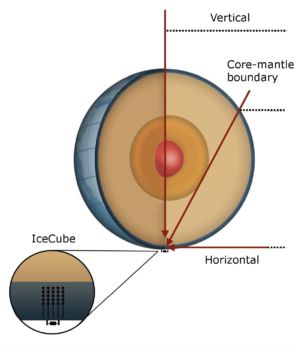
Neutrinos are one of the most plentiful particles out there, as trillions pass through you every second. But they're incredibly hard to work with. They're uncharged, so we can't control their path or accelerate them. They're also nearly massless and barely interact with other matter, so they're hard to detect. All of this means that a lot of the predictions our physics theories make about neutrinos are hard to test.
The IceCube detector, located at the South Pole, has now confirmed a part of the Standard Model of physics, which describes the properties of fundamental particles and their interactions. According to the Standard Model, neutrinos should become more likely to interact with other particles as their energy goes up. To test this, the IceCube team used neutrinos thousands of times more energetic than our best particle accelerators can make and used the entire planet as a target.
Polar cube
IceCube consists of hundreds of detectors buried in the ice under the South Pole. These detectors pick up particles that move through the ice. In some cases, IceCube sees a spray of particles and photons when something slams into one of the atoms in the ice. In other cases, particles simply nudge the atoms, liberating a few photons. There's no neutrino source pointed at IceCube, though. Instead, it relies on natural sources of neutrinos. Some of these are produced far away in space, and travel great distances to Earth. Others are produced as cosmic rays slam into the atmosphere.
In either case, their energies can be immense compared to the best our particle accelerators can do. For the new work, the data included neutrinos with energies as high as 980 Tera-electronVolts. For comparison, the Large Hadron Collider accelerates its protons to a mere 6.5TeV—and only smaller accelerators are used to produce neutrinos.
Because of these immense energies, IceCube is well placed to test a Standard Model prediction: neutrinos are more likely to interact with matter at higher energies. (Physicists refer to the probability of an interaction as a "cross section.") While we've tested this with neutrinos that are produced by some particle accelerators, the tests have only covered a narrow range of energies at the low end of the spectrum. While these tests agreed with the Standard Model, the energies involved never got high enough for the cross section to change.
If IceCube relied only on the neutrinos that interacted with matter within the detector, however, it would take years to build up enough collisions to test things. So instead, the IceCube team used the entire Earth. It's able to detect the path particles take as they pass through the detector. So the team was able to identify neutrinos that passed through the detector by entering on the side. These would be neutrinos that intercepted the Earth tangentially at the South Pole itself and so interacted with very little matter.

These were compared to particles that arrived from beneath and therefore passed through much of the Earth on the way. At low energies, neutrino interactions are so uncommon that this makes little difference. At sufficiently high energies, however, the Earth should provide a test of interaction frequencies.
Still the Standard
As predicted, the number of neutrinos arriving through the Earth dropped compared to the ones coming in tangentially. And their frequency dropped further as a product of energy. While there were still more neutrinos arriving than predicted by the Standard Model, the experimental uncertainty was large enough that the results were completely consistent with our theory.
Across the energy range involved here, the increase in interactions went up in a linear fashion as the energy increased. But there was a slight hint of a curve in the data. This is expected because neutrinos interact with regular matter via two particles called the W and Z bosons. Their mass causes a slight deviation from the linear relationship. We'll need more data to really know for sure, but the new analysis was only done with a single year's worth of data from IceCube, and we have six additional years to work with. So expect to hear more on that soon.
The high end of the energy range, at 980TeV, was set simply by the fact that there were very few neutrinos at energies above that. Again, with more data, we should be able to extend this analysis out further. That's rather important, because there are a number of hypothetical ideas—extra dimensions, undiscovered particles called leptoquarks—that call for the rate of interactions to increase dramatically at high energies. So we might be closing in on testing some of these ideas.
Meanwhile, the IceCube people have also been talking with geologists. In a video announcing their results, they note that some of the neutrinos that pass through the Earth will go through the core and others will graze through while avoiding it. With enough data, this will allow us to get a sense of the material properties of the Earth's core, something that's been notoriously difficult to sample.
Nature, 2017. DOI: 10.1038/nature24459 (About DOIs).
Read Again https://arstechnica.com/science/2017/11/icecube-detector-uses-entire-earth-to-measure-interactions-of-neutrinos/Bagikan Berita Ini














0 Response to "IceCube turns the planet into a giant neutrino detector"
Post a Comment